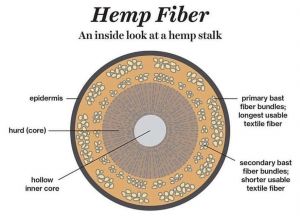Qannabis
Definition
Historical
Paleobotanical studies attest that cannabis was already present about 11 700 years ago in Central Asia near the Altai Mountains. South-East Asia has also been proposed as an alternative region for the primary domestication of cannabis.
Some 12,000 years ago, after the last glacial period, cannabis seeds followed the migration of nomadic peoples and commercial exchanges. This joint migration is an example of symbiosis comparable to the alliance of humans and canids.
Technical
Cannabis sativa is an annual plant of the family Cannabinaceae. It has erected stems which (depending on the environmental conditions and the genetic variety) can reach up to 5 meters.
The palmate leaves, usually composed of five to seven leaflets, are linear-lanceolate, tapering at both ends and the margins sharply serrate.
It is dioecious, but sometimes monoecious:
- Male flowers do not present petals, axillary or terminal panicles, have five yellowish tepals and five anthers.
- Female flowers germinate in the axils and terminally with one single-ovulate closely adherent perianth.
Moreover, C. sativa is rich in trichomes, epidermal glandular protuberances covering the leaves, bracts, and stems of the plant. These glandular trichomes enclose secondary metabolites as phytocannabinoids, responsible for the defence and interaction with herbivores and pests, and terpenoids, which generate the typical smell of the C. sativa. [1]
Production
Soil
Seed
Stalk
Flower
At least 538 natural compounds have been identified in C. sativa. Of these, more than 100 are identified as phytocannabinoids, because of the shared chemical structure. From a chemical point of view, phytocannabinoids have a lipid structure featuring alkylresorcinol and monoterpene moieties in their molecules. Moreover, they are mostly present in the resin secreted from the trichomes of female plants, while male leaves of C. sativa have few glandular trichomes that can produce small amounts of psychoactive molecules.
Over 200 Terpenoids, responsible for the fragrance of C. sativa, have been identified in the flower, leaves of the plant, and may represent 10% of the trichome contents . Limonene, myrcene, and pinene are most common and highly volatile. They are repellent to insects and act as antifeedants for grazing animals. The mixture of different C. sativa terpenoids and phytocannabinoid acids shows a synergistic mechano-chemical defensive strategy against many predators. The terpenoid production changes with environmental specific conditions. Indeed, as observed for the phytocannabinoids, terpenoids are produced as a defence mechanism: the amount of terpenoids increases with the light exposure (stressful condition for the plant) but decreases with soil fertility.
Application
Soil
- Remediation
- Aeration
Seed
- Foodstuffs
"feed" vs "food"
- Oils
FOODMEDS(edible,topical) * PLASTIC * BIODIESEL
To make biodiesel from hemp, you will need to extract the oil from the plant material. Hemp seeds contain a high percentage of oil, and this oil can be used to make biodiesel.
To make biodiesel from hemp, you will need to follow these steps:
1. Extract the oil from the plant material.
2. Process the oil to remove impurities.
3. Use the processed oil to make biodiesel.
Stalk
graphic: skin(bast(hurd/shiv(0)) define: decortication
The hemp bast is the soft, inner layer of the hemp plant's bark. It is used to make rope, twine, and fabric. The hurd is the woody core of the hemp plant. It is used to make paper, animal bedding, and composite wood products.
As a general rule, the bast is used for softer applications while the hurd is used for tougher applications.
Decortication is the process of removing the hemp plant's outermost layer, the bark. This can be done mechanically, with a machine that strips the bark off in one pass, or manually, by stripping it off by hand.
Decortication can also be used to process other plant materials, such as flax, jute, and kenaf.
Decortication separates the hurd from the bast by breaking up the stem of the plant. This can be done with a machine that uses spikes or knives, or by hand.
The bast fibers are then separated from the hurd by a process called retting. This can be done chemically, with a solution of water and enzymes, or mechanically, with a machine that strips the bast fibers off of the hurd.
- Fiber
bast: PLASTIC * CLOTHES * ROPE * INSULATION hurd: CONCRETE * WOOD * PAPER * BEDDING
For animals, the hurd is often used as bedding because it is absorbent and doesn't harbor bacteria like straw or hay. As a feed, the hurd is high in fiber but low in nutrients. It is sometimes used as a filler in animal feed mixes.
- Char
CHARGERS * Biochar
- Fuel
ETHANOL * SYNTHGAS
To make ethanol from hemp, you will need to extract the cellulose from the plant material. Cellulose is the main component of plant cell walls, and it is what gives plants their structure. To extract the cellulose, you can use a process called hydrolysis. Hydrolysis is a chemical reaction that breaks down the cellulose into smaller molecules.
Once the cellulose has been extracted, you will need to ferment it. Fermentation is a process that breaks down the cellulose into sugars. These sugars can then be used to make ethanol.
To make ethanol from hemp, you will need to follow these steps:
1. Extract the cellulose from the plant material.
2. Ferment the cellulose.
3. Use the fermented sugar to make ethanol.
